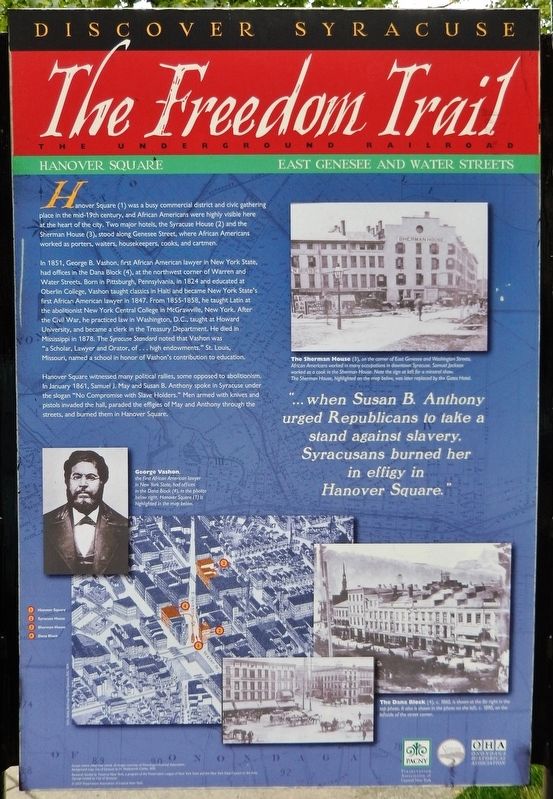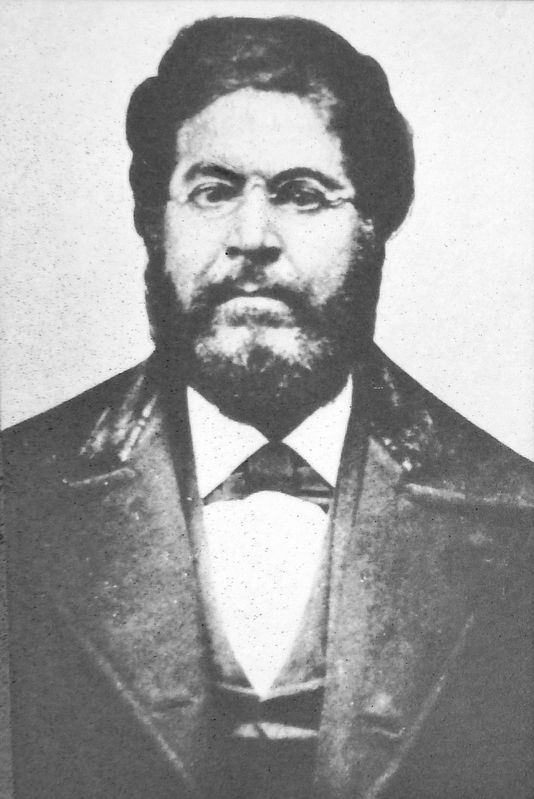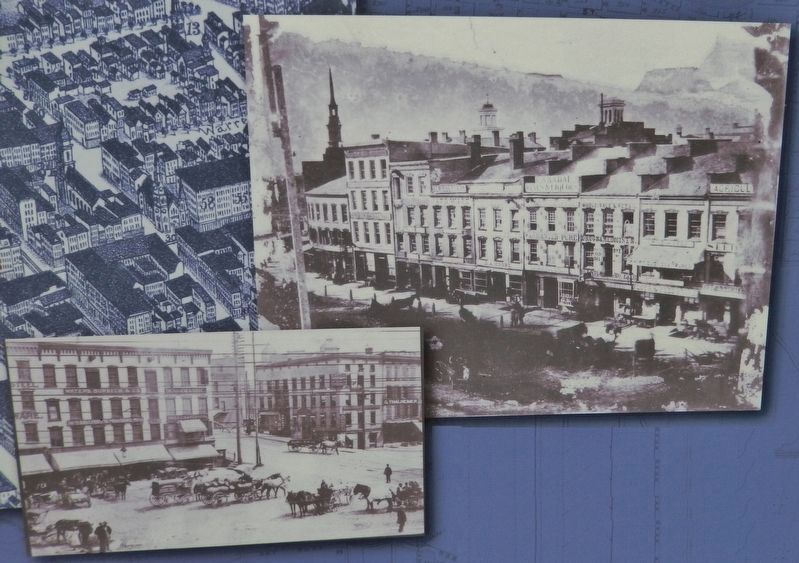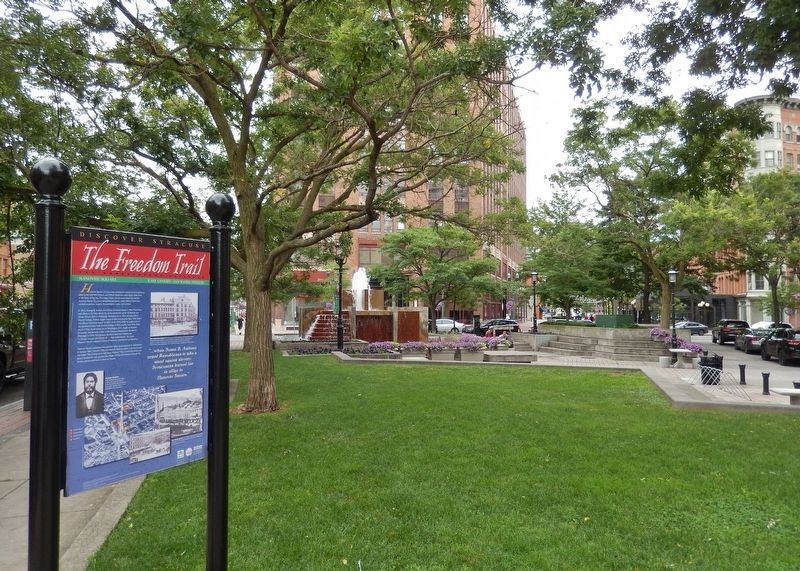Downtown in Syracuse in Onondaga County, New York — The American Northeast (Mid-Atlantic)
Hanover Square
The Freedom Trail
— The Underground Railroad —
Hanover Square (1) was a busy commercial district and civic gathering place in the mid-19th century, and African Americans were highly visible here at the heart of the city. Two major hotels, the Syracuse House (2) and the Sherman House (3), stood along Genesee Street, where African Americans worked as porters, waiters, housekeepers, cooks, and cartmen.
In 1851, George B. Vashon, first African American lawyer in New York State, had offices in the Dana Block (4), at the northwest corner of Warren and Water Streets. Born in Pittsburgh, Pennsylvania, in 1824 and educated at Oberlin College, Vashon taught classics in Haiti and became New York State's first African American lawyer in 1847. From 1855-1858, he taught Latin at the abolitionist New York Central College in McGrawville, New York. After the Civil War, he practiced law in Washington, D.C., taught at Howard University, and became a clerk in the Treasury Department. He died in Mississippi in 1878. The Syracuse Standard noted that Vashon was "a Scholar, Lawyer and Orator, of . . . high endowments." St. Louis, Missouri, named a school in honor of Vashon's contribution to education.
Hanover Square witnessed many political rallies, some opposed to abolitionism. In January 1861, Samuel J. May and Susan B. Anthony spoke in Syracuse under the slogan "No Compromise with Slave Holders." Men armed with knives and pistols invaded the hall, paraded the effigies of May and Anthony through the streets, and burned them in Hanover Square.
Erected by Preservation Association of Central New York, City of Syracuse, and Onondaga Historical Association. (Marker Number 6.)
Topics and series. This historical marker is listed in these topic lists: Abolition & Underground RR • African Americans • Civil Rights • Women. In addition, it is included in the Historically Black Colleges and Universities series list.
Location. 43° 3.028′ N, 76° 9.08′ W. Marker is in Syracuse, New York, in Onondaga County. It is in Downtown. Marker is at the intersection of East Water Street and East Genesee Street, on the right when traveling east on East Water Street. Marker is located beside the sidewalk at the west end of Hanover Square. Touch for map. Marker is in this post office area: Syracuse NY 13204, United States of America. Touch for directions.
Other nearby markers. At least 8 other markers are within walking distance of this marker. Alexis de Tocqueville (a few steps from this marker); City Center (about 300 feet away, measured in a direct line); Lafayette's Tour
(about 300 feet away); Pitts Park (about 500 feet away); Onondaga Indians (about 500 feet away); The Jerry Rescue (about 500 feet away); Courier Building (about 500 feet away); The Banks of the Erie Canal (about 600 feet away). Touch for a list and map of all markers in Syracuse.
Related markers. Click here for a list of markers that are related to this marker. Syracuse Freedom Trail & Underground Railroad
Also see . . . George Boyer Vashon. After the Fugitive Slave Act of 1850, Vashon became involved in the Underground Railroad and state and national conventions. These forums brought blacks together to discuss critical issues confronting their communities and the means of ending the system of slavery. (Submitted on September 5, 2019, by Cosmos Mariner of Cape Canaveral, Florida.)
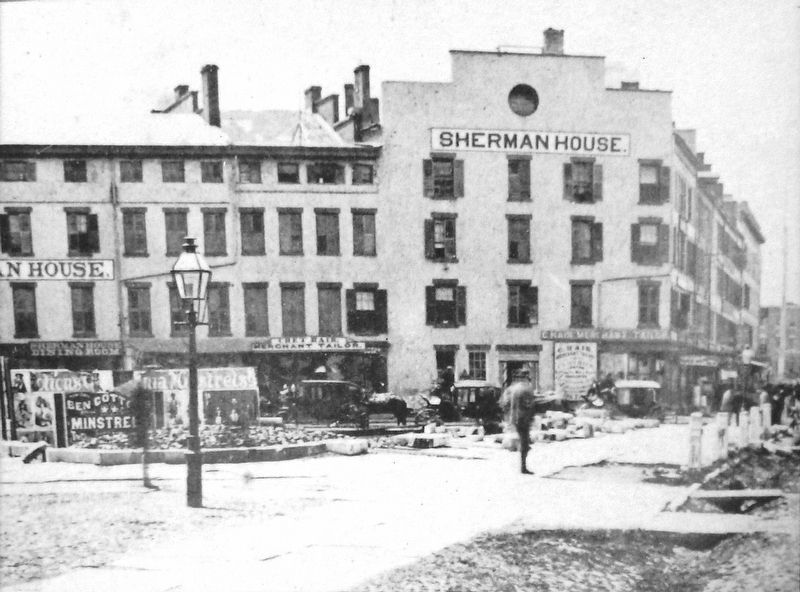
Courtesy of Onondaga Historical Association
3. Marker detail: The Sherman House, on the corner of East Genesee and Washington Streets
African Americans worked in many occupations in downtown Syracuse. Samuel Jackson worked as a cook in the Sherman House. Note the sign at left for a minstrel show. The Sherman House was later replaced by the Gates Hotel.
Credits. This page was last revised on February 16, 2023. It was originally submitted on September 3, 2019, by Cosmos Mariner of Cape Canaveral, Florida. This page has been viewed 384 times since then and 38 times this year. Photos: 1. submitted on September 3, 2019, by Cosmos Mariner of Cape Canaveral, Florida. 2, 3, 4, 5. submitted on September 5, 2019, by Cosmos Mariner of Cape Canaveral, Florida.
